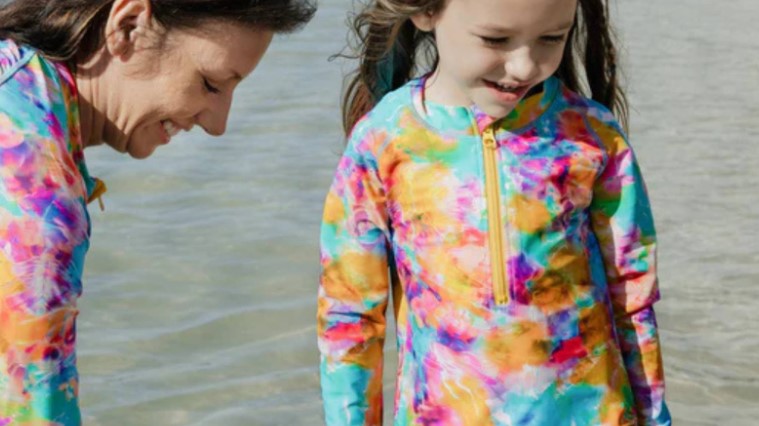
What is the best color swimsuit to wear in a lake?
Lake water contains sediment and plants that reduce underwater visibility. When swimming in a lake, you need bright-colored swimsuits so others can spot you. The right swimsuit color increases your lake safety without compromising style.
Quick links:
Why swimsuit color matters in lakes
Best colors for lake swimming visibility
Colors to avoid when swimming in lakes
More water safety tips for lake swimming
The SwimZip neon collection features high-visibility swimwear that stands out in all bodies of water. Our bright swimsuits, rash guards, swim shorts, and more improve your family's visibility in the water and provide UPF 50+ sun protection during water activities.
Why swimsuit color matters in lakes
Lake water contains natural sediment and plant matter that absorbs light differently than chlorinated pools. Your bright blue swimsuit might stand out at the community pool but become hard to see in a lake. Visibility is a safety issue when you swim with your family. Parents who can easily spot their children in pools may lose sight of them in even shallow lakes.
Weather conditions compound visibility problems. When a sunny day turns cloudy, visibility becomes even worse. Wind also creates surface chop that distorts visibility. The color of your family's swimwear directly impacts how quickly you can locate them or they can locate you in changing conditions.
Best colors for lake swimming visibility
The most visible swimsuit colors contrast with natural water colors and maintain visibility in changing conditions.
Neon yellow and green
Neon yellow and lime green provide maximum visibility in lake environments. These colors create a strong contrast against the darker lake water and remain visible even when natural debris clouds the water.
Aquatic safety experts recommend these colors for lake outings because they break through murky water and stay visible from the shore.
For example, our Neon Green Rash Guard is stylish and highly visible in lakes. The bright colors stand out against natural water tones, while the UPF 50+ fabric blocks harmful UV rays.
Bright orange
Bright orange maintains visibility against the brown and green backgrounds typical in lakes and stands out in sunny and overcast conditions.
Search and rescue teams use orange for water equipment because it stays visible in natural water environments where blues and greens fade quickly.
Try our Neon Orange Euro Swim Shorts with an elastic waistband and adjustable tie waist drawstring closure for flexible sizing. The bright orange fabric keeps swimmers visible against the natural colors of lake water.
Neon pink
Neon pink creates a striking contrast in lakes. This vibrant color lacks natural counterparts in lake ecosystems, so it is immediately noticeable against murky backgrounds.
Parents appreciate neon pink swimwear because the color stands out from shores, docks, and boats as light conditions change throughout the day.
If you prefer more coverage than traditional swimsuits, check out our Neon Pink Tankinis. Their sporty, high neckline at the front provides optimal sun protection, and the internal bra gives moderate support.
Bright white
Bright white creates a distinct silhouette in lake water. This color reflects available light and produces a visible glow, even in deeper sections with less light penetration.
Our White Rash Guard with contrast stitching keeps swimmers visible and provides full UPF 50+ protection against harmful rays during extended lake activities.
Colors to avoid when swimming in lakes
Some swimsuit colors create serious visibility hazards in lake environments. These colors either blend with the natural water conditions or lose visibility quickly as light diminishes with depth.
Dark green and olive
Dark green and olive swimsuits practically disappear in lakes. These colors match the natural algae and plant matter present in most lake environments. Their similarity to the water makes these colors dangerous for swimmers who need to be spotted quickly.
Brown and tan
Brown and tan swimwear blends with the sediment-rich water found in most lakes. These earth tones mimic the natural components of lake water, creating an unintended camouflage effect. In murky conditions, swimmers wearing these colors become nearly invisible.
Black
Black swimwear absorbs rather than reflects light in lake water. This quality makes black suits fade from view, especially as swimmers move to deeper sections where less natural light penetrates. Black creates a visibility problem even in clear lakes.
Navy blue
Navy blue presents significant visibility challenges in lakes. This dark color lacks contrast against the natural water tones and shadows. Navy swimwear becomes difficult to spot as the distance from shore increases.
Dark purple
Dark purple absorbs more light wavelengths than it reflects, reducing visibility. In lakes with brownish water, dark purple blends with natural shadowy areas.
Camouflage patterns
Camouflage-patterned swimwear, regardless of base color, creates dangerous visibility issues in lakes. These patterns blend with natural environments and perform as intended, hiding swimmers in freshwater.
Summer safety tips for lake swimming
Lakes present safety challenges pools don't: unpredictable depths, hidden underwater obstacles, and currents that change without warning. Even expert swimmers should take precautions when swimming in lakes.
Beyond visible swimwear, these lifesaving water safety practices protect your family during lake activities:
-
Swim with a buddy; never go alone, regardless of swimming ability.
-
Check local water conditions before entering (temperature, currents, water quality).
-
Learn basic water rescue techniques and CPR.
-
Establish clear boundaries for children based on swimming ability.
-
Maintain constant parental supervision to keep children safe in and around water.
-
Use U.S. Coast Guard-approved life jackets for children and those with basic swimming skills.
-
Avoid alcohol consumption before and during swimming.
-
Enter the water feet first to check for hidden obstacles or sudden depth changes.
-
Keep a phone nearby for emergencies.
-
Take breaks to prevent fatigue.
-
Learn the dangers of your lake (underwater safety hazards, boat traffic patterns).
-
Check the weather before you go to anticipate changing conditions.
How SwimZip swimwear boosts lake safety
SwimZip prioritizes safety in our water-friendly swimwear designs. Our neon collection features visibility-enhancing colors selected to stand out in all water environments. Each piece contains UPF 50+ sun-protective fabric that blocks 98% of harmful UV rays while maintaining the bright colors that make swimmers easy to spot in pools, oceans, and lakes.
Unlike standard swimwear that fades after exposure to sun and water, SwimZip garments maintain their vibrant colors through many seasons. Our durable materials resist breakdown from the chlorine, salt, and natural elements in different water environments.
Check out our new collection with bright-colored patterns and amazing designs to find your favorite summer swimwear!
Best swimwear color for lakes FAQ
What are the least visible colors in the water?
Darker colors are the least visible colors in the water as they vanish at depth, creating safety risks. Black and dark blue swimsuits absorb light rather than reflect it, reducing visibility. An underwater swimmer quickly disappears in a dark green or purple suit. Even in pools, darker swimwear resembles leaves or shadows on the bottom.
This visibility problem worsens in shallow water, where light bounces unpredictably. Water safety experts advise against dark suits since they practically disappear beyond 15 feet deep. Bright swimwear remains the safest choice to prevent drownings.
What are the safest colors for swimming?
Neon yellow, bright orange, and fluorescent green provide maximum swimming safety. These colors remain visible despite environmental factors such as murky water, changing light, and varying depths. Fluorescent colors create strong contrast in all water conditions, so swimmers are easier to spot in emergencies.
How does water clarity affect swimsuit visibility in lakes?
Water clarity varies between lakes. Clear lakes with minimal sediment allow light to penetrate deeper, making more swimsuit colors visible. Murky lakes with poor water clarity require brighter swimwear colors to compensate. Even in clear lakes, swimsuit visibility decreases quickly with depth, so bright neon colors are the safest choice regardless of water clarity.
Why do gray swimsuits perform differently than other darker colors underwater?
Gray swimsuits don't perform worse than black or navy underwater. Black completely disappears while gray creates a confusing silhouette that resembles shadows or rocks. This makes gray hard to spot in lakes with varied bottoms, but total disappearance (black/navy) remains the greater safety risk.
How does swimsuit color visibility change at different times of day?
Swimsuit color visibility fluctuates as natural light changes. The morning and the late afternoon sun create more angled light penetration in water, reducing the visibility of all colors. Midday offers the best visibility, but even then, light colors and fluorescent options outperform darker alternatives. For late-day swimming, prioritize the brightest neon yellows and whites that maximize available light reflection.
What color swimsuits are the best for water parks?
Water parks present different visibility challenges than natural lakes. The controlled environment at water parks features clear water and consistent depths, but high swimmer density creates unique risks. Bright neon colors provide optimal visibility so parents can track children in crowded wave pools and slides. Hot pink and fluorescent orange color swimwear stands out well against the manufactured blue backgrounds common at water parks.
How important are neon swimsuit bottoms for visibility?
Neon swimsuit bottoms are just as important as neon tops for water safety. You’ll be most visible wearing both.
What swimwear colors help instructors during swim lessons?
Instructors at swim lessons track students more effectively when children wear high-visibility swimwear. Parents should dress even the strongest swimmers in bright colors during lessons so instructors can quickly identify their position in group settings. Bright swimwear is an additional layer of protection that complements—rather than replaces—proper supervision and flotation devices.
Further reading
What is the best swimsuit color to wear in the swimming pool?
What is the best swimsuit color to wear in the ocean?
What is the best swimsuit for an apple shape?
Can you swim in the ocean during your period?



Leave a comment
This site is protected by hCaptcha and the hCaptcha Privacy Policy and Terms of Service apply.